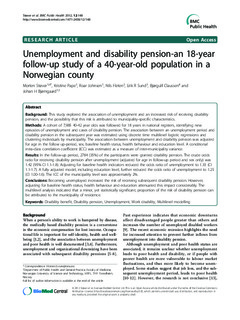Unemployment and disability pension-an 18-year follow-up study of a 40-year-old population in a Norwegian county
Støver, Morten; Pape, Kristine; Johnsen, Roar; Fleten, Nils; Sund, Erik Reidar; Claussen, Bjørgulf; Bjørngaard, Johan Håkon
Journal article, Peer reviewed
Permanent lenke
http://hdl.handle.net/11250/1539206Utgivelsesdato
2012Metadata
Vis full innførselSamlinger
Sammendrag
Background: This study explored the association of unemployment and an increased risk of receiving disability
pension, and the possibility that this risk is attributed to municipality-specific characteristics.
Methods: A cohort of 7,985 40-42 year olds was followed for 18 years in national registers, identifying new
episodes of unemployment and cases of disability pension. The association between an unemployment period and
disability pension in the subsequent year was estimated using discrete time multilevel logistic regressions and
clustering individuals by municipality. The association between unemployment and disability pension was adjusted
for age in the follow up-period, sex, baseline health status, health behaviour and education level. A conditional
intra-class correlation coefficient (ICC) was estimated as a measure of inter-municipality variance.
Results: In the follow-up period, 2784 (35%) of the participants were granted disability pension. The crude odds
ratio for receiving disability pension after unemployment (adjusted for age in follow-up period and sex only) was
1.42 (95% CI 1.1-1.8). Adjusting for baseline health indicators reduced the odds ratio of unemployment to 1.33 (CI
1.1-1.7). A fully adjusted model, including education level, further reduced the odds ratio of unemployment to 1.25
(CI 1.00-1.6). The ICC of the municipality level was approximately 2%.
Conclusions: Becoming unemployed increased the risk of receiving subsequent disability pension. However,
adjusting for baseline health status, health behaviour and education attenuated this impact considerably. The
multilevel analysis indicated that a minor, yet statistically significant, proportion of the risk of disability pension can
be attributed to the municipality of residence.
